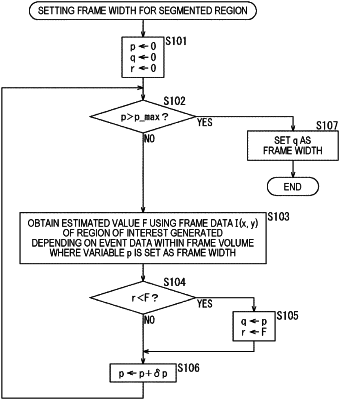| CPC H04N 25/443 (2023.01) [H04N 25/50 (2023.01); H04N 25/47 (2023.01); H04N 25/707 (2023.01)] | 28 Claims |

|
1. A data processing device, comprising:
a frame data generation unit configured to generate first frame data and second frame data, the first frame data being based on event data indicating a variation in an electrical signal of a pixel generating the electrical signal by performing photoelectric conversion, the event data occurring during a first accumulation time from a first frame generation start time to a first frame generation end time, and the second frame data being based on event data occurring during a second accumulation time from a second frame generation start time to a second frame generation end time;
a frame period setting unit configured to set and supply a first frame period to the frame data generation unit, the first frame period being a period from the first frame generation start time to the second frame generation start time; and
an accumulation time setting unit configured to set and supply the first accumulation time and the second accumulation time to the frame data generation unit,
wherein the accumulation time setting unit is further configured to switch between setting the first and second accumulation times on a basis of time and setting the first and second accumulation times depending on a number of the event data in response to a user operation, and
wherein the accumulation time setting unit sets the first and second accumulation times in units of segmented regions, the segmented regions obtained by dividing a frame of each of the first and second frame data into a plurality of regions, based on a corresponding plurality of objects within the frame.
|